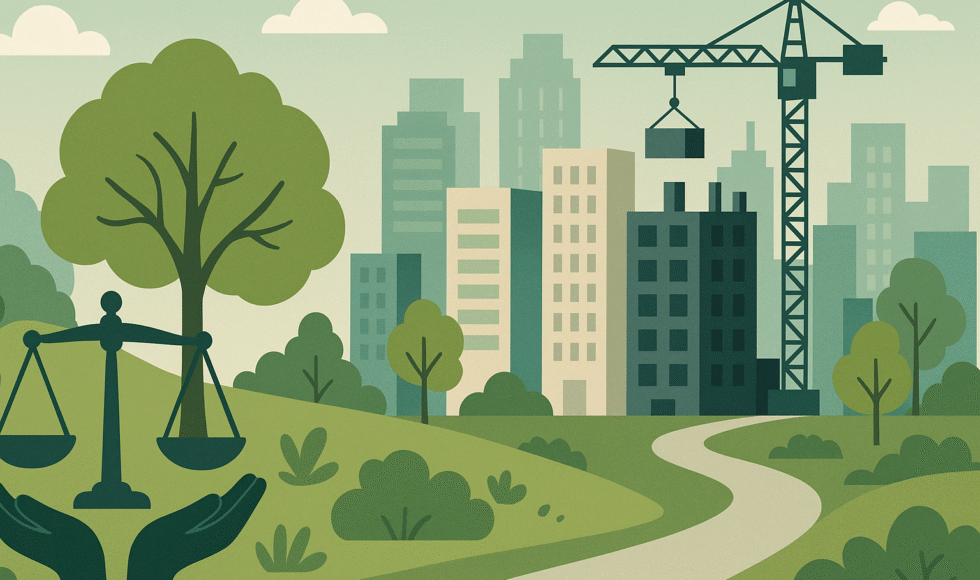Cities are constantly evolving, and with each new construction or reconstruction, there’s a new array of legal, environmental, and social considerations. Urban renewal isn’t merely constructing bigger buildings or reconstructing the space—it’s discovering that fine line between economic progress and protecting the environment. That’s where environmental law enters the picture, shaping how cities are developed and maintaining what matters most.
Why Environmental Law Matters to City Planning
Urban areas have unique environmental challenges. Pollution, illegal dumping of waste, and the destruction of green areas are some of the issues that can be amplified as cities expand. Environmental laws are a guide as well as a watchdog. They mandate that new development does not occur at the expense of clean air, clean water, and environmental equilibrium.
Urban renewal schemes have to satisfy environmental controls which include:
- Land use and zoning
- Waste recycling and disposal
- Emission controls
- Water consumption and quality
- Protection of natural environments
These legal requirements impose a burden on developers and municipalities but also provide a basis for developing smarter and greener.
Sustainability Goals Driving Transformation
The conception of a national or state green policy approaches complexity as states continue to implement more stringent sustainability goals. Urban or metropolitan development now includes features such as green-roofing, green construction materials, and effective public transport connectivity. Legal reforms have taken place to facilitate and promote the adoption of sustainable processes; promote incentives for clean energy; and require environmental effect assessments prior to construction.
Such changes indicate a mindset made. Redevelopment isn’t about size or looks—it’s sustainable livability. Law has a vital role in mandating adherence to those values in a measurable way, not merely promises.
The Need for Greener Building Practices
Conventional building techniques are a major source of carbon emissions and landfill waste. The environment has reacted by encouraging cleaner, more efficient building techniques. Regulations now touch on everything from the building materials brought on-site to how the debris is managed after construction is complete.
There is greater need for subcontractors and contractors who are familiar with these shifting needs. Professionals familiar with sustainable methods and being green certified are in greater demand. It is not just construction; it’s being able to build within the parameters of the current environmental needs.
It is now more beneficial for redevelopment professionals to take renewable energy short courses. The courses provide insight into solar, wind, and other energy-efficient designs that need to be incorporated into new work or retrofits. Having an idea of how to do so within the law can simplify planning and approvals.

Legal Concerns in Brownfield Redevelopment
Re-developing polluted or abandoned land—also referred to as brownfields—is extremely complex. The land is normally heavily environmentally cleaned up prior to the construction process. Environmental law governs the procedure, which guarantees that soil, water, and air contamination are dealt with appropriately.
The legal requirements of brownfield redevelopment characteristically include:
- Environmental site assessments
- Cleanup and mitigation activities
- Monitoring and long-term maintenance
- Community disclosure and reporting
Neglecting these requirements could result in legal action, construction delays, and financial fines. That is why environmental lawyers and consultants usually take center stage in these developments, advising developers to keep on the right legal and moral path.
Balancing Preservation and Growth
Historic neighborhoods, wetlands, and other sensitive regions must be handled sensitively in redevelopment. Environmental laws help control the manner in which these areas are developed or intensified. While this may restrict certain redevelopment plans, it helps maintain the character and environmental integrity of urban areas.
Developers and planners need to have mechanisms to thoughtfully integrate new infrastructure within respect for these boundaries. Sometimes that involves relocating a building footprint. Other times it involves using materials or designs that disrupt the environment as little as possible.
Coordination among city planners, environmental lawyers, and residents is required to find that balance. It’s not a checklist—it’s an ongoing conversation that’s refined with each project.
The Role of Local Contractors
Local compliance can be made more efficient through collaboration with local specialists. A general contractor Kirkland Seattle, for instance, would be more likely to possess firsthand knowledge of Washington State environmental building standards and Seattle green sustainability codes. Local specialists can reduce blunders and expedite the approval process, especially when redevelopment encroaches on protected lands or is publicly funded.
Urban renewal is aided by more than by legislation—it evolves through collaboration with specialists keenly sensitive to how to work around environmental issues and adapt to changing norms.

Emerging Real Estate Laws and Property
Real estate laws also cross over into environmental law. Green-certified building rental rates, energy efficiency disclosure requirements, or compliance with state incentives for green design are all components of the emerging legal framework surrounding property.
These changes are a consequence of a growing need from the government and tenants alike. Both buyers and tenants increasingly look for houses with green values, and therefore not complying is not only against the law but also noncompetitive.
Talking across these intersecting legal regimes—real estate and environmental—is part of what makes urban redevelopment challenging and rewarding. Developers who take note of this intersection are more apt to build structures that last, both physically and legally.
Environmental law is not just the backdrop against which cities are remade—it’s a catalyst. From promoting clean energy to requiring land restoration, these clusters of law shape the cities of tomorrow. They push developers, contractors, and planners to approach construction differently, inspiring innovation as they preserve common resources. As the calls for sustainable cities grow, so does the demand to learn about the laws that make them possible.

